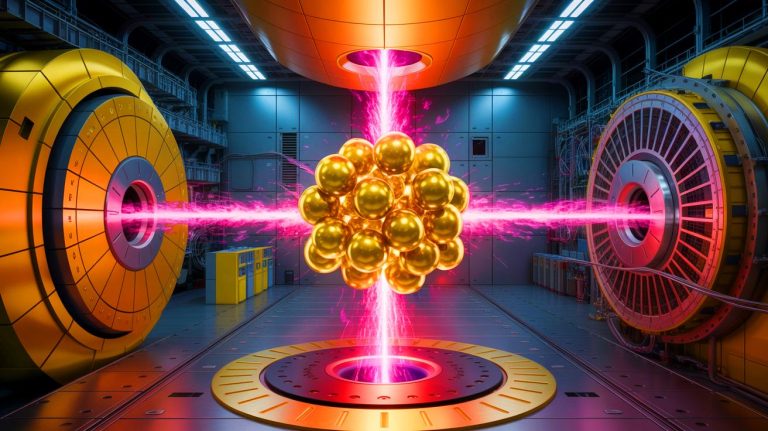| IN A NUTSHELL |
|
In a groundbreaking development, physicists at CERN’s Large Hadron Collider (LHC) have successfully transformed lead into gold through high-energy particle collisions. This achievement resonates with the age-old quest of alchemists, although it occurs on a subatomic scale and lasts only fleetingly. By leveraging the LHC’s capabilities, scientists have made a significant leap forward in our understanding of nuclear reactions and the potential of modern alchemy. This article delves into the intricate processes, distinct signatures, and future prospects of this remarkable scientific breakthrough.
Leveraging the Power of LHC
The Large Hadron Collider (LHC) is renowned for its ability to accelerate particles to near-light speeds, creating conditions akin to those just after the Big Bang. In this experiment, lead nuclei were propelled to incredible velocities, enabling scientists to observe direct transmutation into gold. This transformation was not merely a flight of fancy but a carefully orchestrated series of events. The ALICE collaboration focused on “near-miss” collisions where electromagnetic fields generated virtual photons. These photons interacted with lead nuclei, stripping away protons and resulting in the formation of gold.
The quark–gluon plasma state, believed to have existed moments after the Big Bang, plays a pivotal role in this process. By achieving this state, researchers can study the fundamental forces that govern matter. The transformation from lead to gold, therefore, is not just a nod to alchemical dreams but a window into the mechanisms that shape our universe. Such high-energy collisions provide insights into nuclear reactions and pave the way for future explorations of particle physics.
Distinct Signatures of Gold Nuclei
Analyzing the aftermath of these high-energy collisions is no small feat. The ALICE Zero Degree Calorimeters (ZDC) were instrumental in identifying the distinct signatures of gold nuclei formation. These detectors are capable of handling both high-intensity collisions and more subtle interactions, allowing for a comprehensive analysis of the transmutation process. The current production rate stands at approximately 89,000 gold nuclei per second during lead-lead collisions, a testament to the precision and capability of the LHC.
Yet, the gold created is ephemeral, existing for only a fraction of a second before it disintegrates. While the quantity of gold might seem negligible—around 29 picograms during Run 2 of the LHC—the significance lies in the process rather than the yield. The fleeting nature of the gold nuclei underscores the challenges and intricacies involved in such high-energy experiments. It highlights the delicate balance between theoretical predictions and experimental realities, pushing the boundaries of what is achievable in modern physics.
Future Prospects and Implications
This milestone is not just a nod to the past but a gateway to future innovations. The experiment’s findings have far-reaching implications for the operation and enhancement of particle accelerators. By testing and refining models of electromagnetic dissociation, researchers can better understand beam losses—a crucial factor limiting the performance of current and future colliders. This knowledge is vital for pushing the boundaries of what these machines can achieve.
While the LHC’s capabilities won’t replace traditional gold mining, they offer a glimpse into the potential of harnessing fundamental forces for practical applications. The research also opens up avenues for exploring nuclear reactions and their applications in various fields, from energy production to medical technologies. The dream of alchemy may remain symbolic, but the scientific insights gained are real and profound, offering new directions for exploration.
The Role of Modern Alchemy in Science
The transformation of lead into gold at CERN is more than a scientific curiosity; it represents the merging of ancient aspirations with modern technology. This experiment, while not producing gold in commercially viable quantities, underscores the power of human ingenuity and the relentless pursuit of knowledge. It highlights how historical quests can inspire contemporary science, leading to discoveries that transcend their original context.
As scientists continue to push the limits of what is possible, the concept of alchemy serves as a reminder of the enduring human desire to understand and manipulate the fundamental elements of nature. It is a testament to the progress made in particle physics and the potential for future breakthroughs. The journey from ancient alchemy to cutting-edge science illustrates the evolving nature of exploration and the endless possibilities that lie ahead.
As we reflect on this achievement, we are left to ponder the next steps in the journey of scientific discovery. What other mysteries might be unraveled by the powerful tools of modern physics, and how will they continue to reshape our understanding of the universe? The quest for knowledge is never-ending, and each breakthrough brings us closer to unlocking the secrets of the cosmos. What discoveries will the next generation of scientists unveil?
Did you like it? 4.6/5 (29)








Wow, alchemy is real! Does this mean gold prices are going to drop? 🤔
Isn’t this just a really expensive way to make a tiny bit of gold?
Can this process be scaled up for commercial use, or is it just for research?
Thank you, CERN, for making science feel like magic again! 🔬✨
How much energy does it take to create those gold nuclei, and is it sustainable?